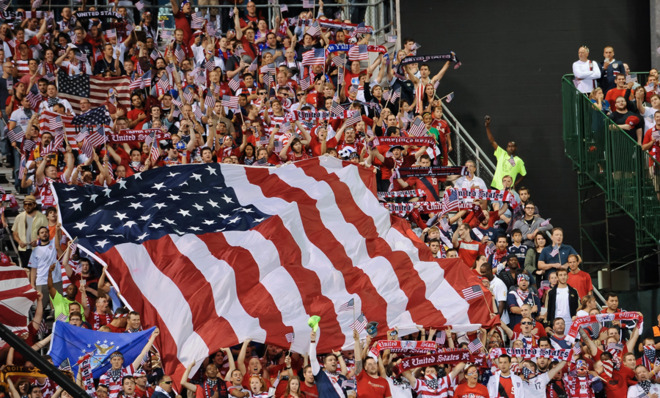Why it's so hard for soccer to find a home in America
Tax-payer-funded stadiums: not so hot right now


David Beckham can't find himself a home in Miami.
The English soccer icon is trying to build a 25,000-seat stadium for his unnamed Major League Soccer team in south Florida, but he continues to see his efforts stymied by city politics, petty feuds, and a variety of other blockades. One site was voted down, then another, and now that pretty English face of his is poking about for another spot, unlikely to find one.
A similar fate has befallen NYCFC, an expansion club that will play its 2015 season (and beyond) in Yankee Stadium, as its rich ownership group — including the Yankees and the oil sheiks behind Manchester City — desperately attempt to find a site somewhere in the five boroughs. A few other MLS teams, such as the New England Revolution and D.C. United, also want to build new soccer-specific stadiums, but they struggle against the anti-stadium political tide.
The Week
Escape your echo chamber. Get the facts behind the news, plus analysis from multiple perspectives.

Sign up for The Week's Free Newsletters
From our morning news briefing to a weekly Good News Newsletter, get the best of The Week delivered directly to your inbox.
From our morning news briefing to a weekly Good News Newsletter, get the best of The Week delivered directly to your inbox.
The point being: It's hard out there for a soccer team looking for a home. Last summer, Aaron Gordon addressed the greater stadium problem on Pacific Standard:
Economists have long known stadiums to be poor public investments. Most of the jobs created by stadium-building projects are either temporary, low-paying, or out-of-state contracting jobs — none of which contribute greatly to the local economy. (Athletes can easily circumvent most taxes in the state in which they play.) Most fans do not spend additional money as a result of a new stadium; they re-direct money they would have spent elsewhere on movies, dining, bowling, tarot-card reading, or other businesses. And for every out-of-state fan who comes into the city on game day and buys a bucket of Bud Light Platinum, another non-fan decides not to visit and purchases his latte at the coffee shop next door. All in all, building a stadium is a poor use of a few hundred million dollars. [Pacific Standard]
MLS squads feel the brunt of the public's growing negativity toward publicly financed stadiums. While a football team — say the Washington Redskins — can threaten to leave the city if they don't get a shiny new building, D.C. United does not have that same pull. It's easy for the politicians to shut down proposals or make it very hard for an MLS team to build a stadium, and use that fact as a talking point to score with his or her constituents. (This isn't to say that public funding should be used to build stadiums; it's just to point out the reality of the situation.)
But what does a home mean to a top-level soccer team? Quite a lot, actually. There are currently 13 soccer-specific stadiums in Major League Soccer, serving 14 of the 19 teams. (The L.A. Galaxy and Chivas USA share the Home Depot Center in Carson, California.) Four of those stadiums — BBVA Compass Stadium, PPL Park, Red Bull Arena, and Sporting Park — have opened since 2010, and those four are among the best viewing experiences in the sport. For a league that needs to emphasize and encourage fans to actually attend games, putting matches in contained venues that are designed for soccer and feature great sight lines is essential. Going to a game with 19,000 other people inside the 68,756-capacity Gillette Stadium isn't something you'd do again; watching the Philadelphia Union play on the shore of the Delaware River is different.
The oldest soccer-specific stadium built for a professional team in America is Columbus Crew Stadium, which opened in 1999. If you go there today, it feels like it's made from high-grade tinfoil and held together with spit and memories. But a decade and a half ago, it was a revelation. While the venue cost only $28.5 million — spit and hope are relatively cheap — it served as a genuine sign that soccer in America was ready to arrive or, at least, that maybe MLS was around to stay. A Major League Soccer team had a home, one that it didn't have to share with a college football team or an NFL team or another squad from an infinitely more popular and better-financed sport.
A free daily email with the biggest news stories of the day – and the best features from TheWeek.com
Since its inception, the outpost in the middle of Ohio has been lapped by newer, nicer, more expensive stadiums. The Crew have had success, finishing first in the league three times and winning an MLS Cup once, but they haven't reached the playoffs in the last two years. Meanwhile, Crew Stadium has grown into a legend in its own right, a result of the United States national team defeating Mexico 2-0 — or dos a cero — four times in World Cup qualifying. The American team doesn't have an official home stadium, instead bouncing around the country at the behest of supporters and bigger paydays elsewhere. Still, when you talk to the players, they love that Crew Stadium has become, in essence, American soccer's de facto home. It's enough to make David Beckham jealous.
Pacific Standard grapples with the nation's biggest issues by illuminating why we do what we do. For more on the science of society, sign up for its weekly email update or subscribe to its bimonthly print magazine.
More from Pacific Standard...
-
 ‘Autarky and nostalgia aren’t cure-alls’
‘Autarky and nostalgia aren’t cure-alls’Instant Opinion Opinion, comment and editorials of the day
-
 Japan’s Princess Aiko is a national star. Her fans want even more.
Japan’s Princess Aiko is a national star. Her fans want even more.IN THE SPOTLIGHT Fresh off her first solo state visit to Laos, Princess Aiko has become the face of a Japanese royal family facing 21st-century obsolescence
-
 Australia’s teen social media ban takes effect
Australia’s teen social media ban takes effectSpeed Read Kids under age 16 are now barred from platforms including YouTube, TikTok, Instagram, Facebook, Snapchat and Reddit